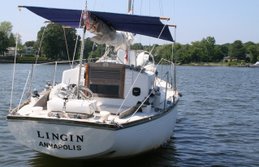This year, the Saturday race saw good winds (10-15 kts) and a very sloppy sea. Unfortunately we did not have the participation numbers we had hoped for; only 4 boats made it out including the Canadian entry.
During the downwind leg, we overtook the Canadian boat (550) while they were having spinnaker trouble. We appeared to maintain our position with 247 during the downwind leg. As a side note, T.C. Williams had C.B. Currier on board and they certainly made a good team. We couldn't make up the difference heading back upwind as 247 smartly covered us.
The second race, we saw 247 line up for a port start and set out to deny it. We did a admirable job of timing the start, coming into the pin on starboard and forcing 247 to duck behind us. I'll admit I enjoyed that. :-)
My joy was short-lived, though. 247 tacked behind and upwind of us and just MOTORED by. We tacked away and they tacked to cover us. We spent the rest of the leg trying anything we could think of to tune the boat in to the conditions, but to no avail. It was very frustrating.
We should have realized, again, that there was a huge shift mid-way up the course again, but I was too frustrated with 247 driving away that I completely missed it. We came around the mark last. Argh.
During the downwind leg we made up on 484 and came close to 550, but in the end took a third.
We rounded the bottom mark behind 550 and went right toward Hackett's Point. 247 went left, and 550 concurred pretty quickly. I liked our speed and the wind seemed to be building on the right side of the course, so to get leverage on the other boats, I went to the lay line. The wind substantially increased and was a huge lift once we tacked. We made out like bandits against 550 and very nearly caught 247.
The race committee was run by Bob Leigh rather than Phil Biegel this year as Phil's house was hit by the tornado that went through
- Thread the Needle. We had a vote at the skippers meeting/potluck dinner and I was the only one that voted against threading the needle. This is a rule that says as you sail up and down the legs, you MUST go through the start/finish line each time. I really don't like this rule as it significantly limits the leverage you can get on your competition. The reasons given for keeping it were that a) it makes it easy for the RC to shorten the course, b) it allowed for better photos (I didn't see anyone with a camera on the RC boat), and c) it was tradition.
- The RC shortened the last race in solid wind. I'll admit that the wind was light during the downwind leg, but that upwind leg things really began to blow. The race was going well and we would have readily made the party afterward. I know the Canadians need to get home, but they made a very long trip to race. Why not give them the full experience?
One last thought on the first day's racing. I spoke with C.B. and T.C. and the rest of our crew. I think perhaps we had things a bit too tight. That while it felt like strong wind, we had things set up a little too strong. If I had it to do again, I'd try a little less jib halyard tension, a little less backstay and a fuller main.
What do you think?
Thanks, Crew, for a great weekend!


No comments:
Post a Comment